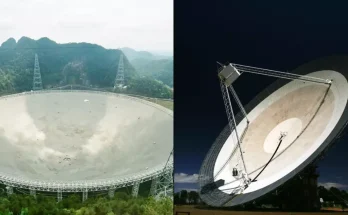A comet not seen by humans for 80,000 years will be visible tonight.
Comet C/2023 A3 will peak in brightness tonight. Credit: Marcos del Mazo/LightRocket/Getty
After the spectacular display put on by the recent Northern Lights – also known as aurora borealis – across both the United States and the United Kingdom in recent days, yet another dazzling display is yet to illuminate the skies.
And it’s a spectacular celestial event you won’t want to miss.
This weekend Comet A3, also known by its scientific name ‘Tsuchinshan-ATLAS’, will be visible to the naked eye, according to reports.
The Royal Astronomical Society (RAS) reported that the comet, which was only discovered last year has been branded “the comet of the century” because of how bright and visible it could potentially be, will light up the night sky as one of the rarest events to occur this year.
It is also one of the rarest phenomena to occur as it has not been seen by humans for approximately 80,000 years.
Where can you see the comet?
Stargazers in the southern hemisphere have already caught a glimpse of Comet A3 but it can now also be seen in various regions across the northern hemisphere.
When is the event scheduled to take place?
Per Forbes, Comet A3 reached its perihelion (that is, the closest it gets to the sun) on September 27 and is today (October 12) that it is at its closest to Earth, passing about 44 million miles (71 million kilometers) distant.
It might also be visible across October 13 and 14, if we’re lucky.
What should you do in preparation?
For those avid space fans eager to catch a glimpse of the spectacle, it has been advised that stargazers look to the west just after sunset, which is around 6:13 PM in London.
The time span ranges across America, but it is also expected to occur in the evening shortly after sunset.
It has also been recommended to be punctual for the event as it will only last for 30-45 minutes before the sun fully sets.
Much like the Northern Lights, it may be worth moving away from areas with high light pollution – but if you do, keep an eye on the weather forecast and wrap up warm.
Comet C/2023 A3 (TsuchinshanATLAS) is expected to peak in our skies on October 12. Credit: Marcos del Mazo/LightRocket/Getty
Prior to today, it seems as though the comet was visible for scientists back in 2023, but not in the same manner as it will be tonight.
According to the BBC Sky at Night Magazine, a long-period comet C/2023 A3 (Tsuchinshan-ATLAS) was spotted back in February 2023 during a sky survey, but scientists realized at the time that it would be getting closer to the Earth September/October 2024, making it visible to the naked eye.
“Now Comet A3 is moving up into the northern hemisphere’s evening sky. All those northern observers who have been desperate to see Comet C/2023 A3 will have their chance to gaze at it through their binoculars and telescopes, and turn their cameras towards it too – weather permitting, of course,” the magazine stated.
So get your binoculars out and head outside tonight at sunset in the hopes that you’ll be able to see it tonight!
.jpg_akR3Is?tr=w-1024,cr-0.0.1024.686&config=JTdCJTIybmFtZSUyMiUzQSUyMkdldHR5SW1hZ2VzLTIxNzUzNTQ4MTclMjAoMSkuanBnJTIyJTJDJTIyYWx0ZXJuYXRpdmVfdGV4dCUyMiUzQSUyMkdldHR5SW1hZ2VzLTIxNzUzNTQ4MTclMjAoMSkuanBnJTIyJTJDJTIyY2FwdGlvbiUyMiUzQSUyMkNvbWV0JTIwQyUyRjIwMjMlMjBBMyUyMChUc3VjaGluc2hhbkFUTEFTKSUyMGtub3duJTIwYWxzbyUyMGFzJTIwJTVDJTIydGhlJTIwY29tZXQlMjBvZiUyMHRoZSUyMGNlbnR1cnklNUMlMjIlMjBpcyUyMHNlZW4lMjBjcm9zc2luZyUyMHRoZSUyMHNreSUyMGR1cmluZyUyMHN1bnJpc2UlMjBhdCUyME1vbmZyYWd1ZSUyME5hdGlvbmFsJTIwUGFyay4lMjBDcmVkaXQlM0ElMjBNYXJjb3MlMjBkZWwlMjBNYXpvJTJGTGlnaHRSb2NrZXQlMkZHZXR0eSUyMiUyQyUyMmNvb3JkaW5hdGVzJTIyJTNBJTdCJTIyZGVza3RvcCUyMiUzQSU3QiUyMmxlZnQlMjIlM0EwJTJDJTIydG9wJTIyJTNBMCUyQyUyMnJpZ2h0JTIyJTNBMSUyQyUyMmJvdHRvbSUyMiUzQTAuNjclN0QlMkMlMjJ0YWJsZXQlMjIlM0ElN0IlMjJsZWZ0JTIyJTNBbnVsbCUyQyUyMnRvcCUyMiUzQW51bGwlMkMlMjJyaWdodCUyMiUzQW51bGwlMkMlMjJib3R0b20lMjIlM0FudWxsJTdEJTJDJTIybW9iaWxlJTIyJTNBJTdCJTIybGVmdCUyMiUzQW51bGwlMkMlMjJ0b3AlMjIlM0FudWxsJTJDJTIycmlnaHQlMjIlM0FudWxsJTJDJTIyYm90dG9tJTIyJTNBbnVsbCU3RCU3RCUyQyUyMndpZHRoJTIyJTNBMTAyNCUyQyUyMmhlaWdodCUyMiUzQTY4MSU3RA==)



